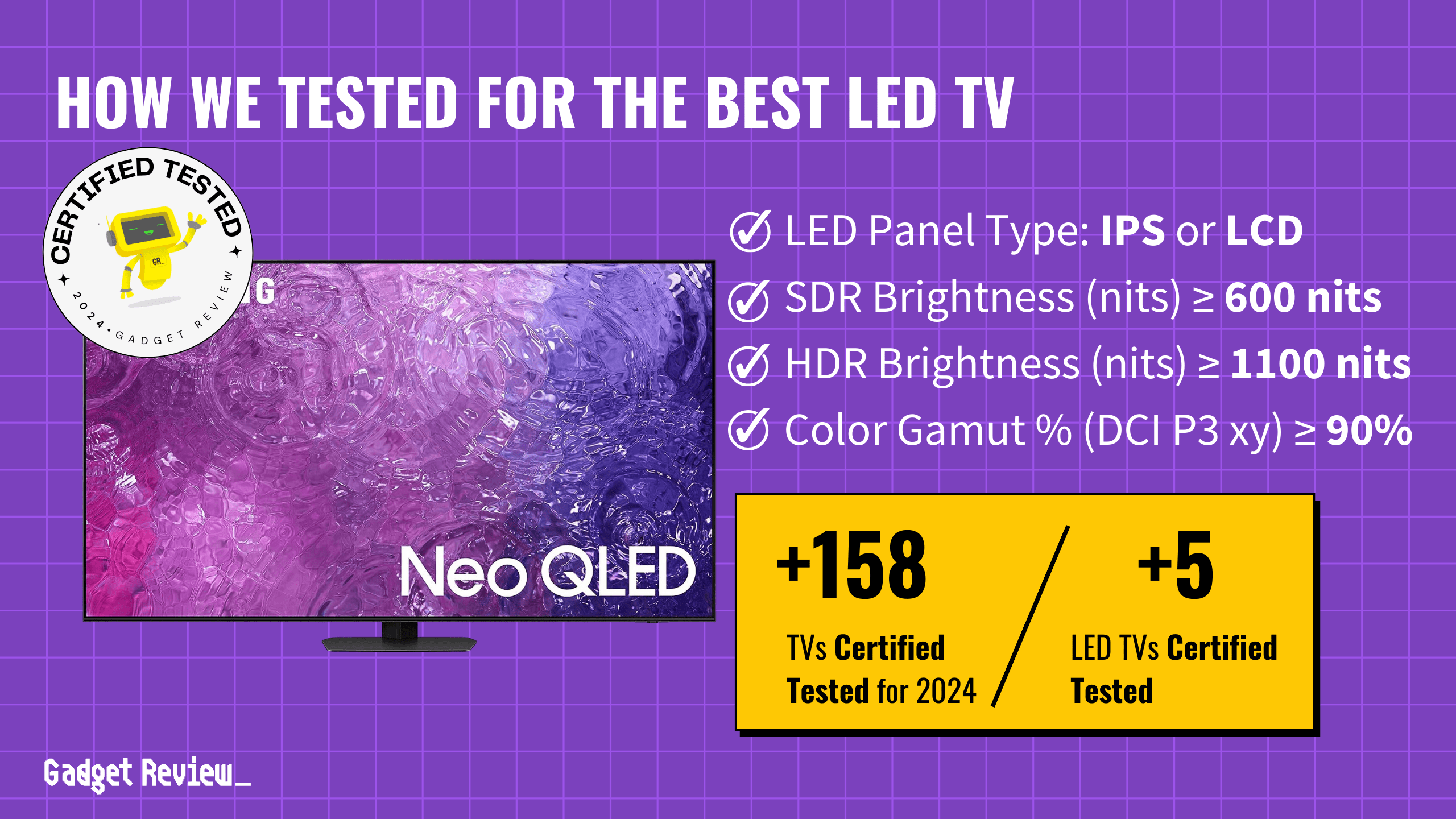You don’t have to break the bank to enjoy premium picture quality with the best LED TV. Opting for LED means sidestepping the hefty OLED price tag and the potential for burn-in issues, offering you both savings and peace of mind. The market is filled with affordable options, notably from brands like HiSense and TCL, that leverage MiniLED and QLED technology.
This means even with a budget under $1000, you can access excellent TVs that provide vibrant colors, deep blacks, and sharp details. So, whether it’s binge-watching your favorite series or enjoying the big game, a great LED TV ensures you won’t miss out on quality, all while keeping your wallet intact.
How Did We Rank the Best LED TV?
To assess how high or low quality an LED TV actually is, one must evaluate specific testing criteria against reference industry standards. Using our thorough TV Testing Methodology, we determined there are 1 minimum specs and 6 criteria below (3 required, 3 nice to have) that ensure your LED TV looks as good as the creator intended it.
Minimum Specifications
- LED Panel Type: IPS, LCD, LED, Mini LED, Mini-LED QLED, NanoCell LED, Neo QLED, QLED, Quantum LED, Quantum ULED, Standard LED, or VA.
Test Criteria
- SDR Brightness: Equal to or greater than 600 nits for optimal clarity in standard dynamic range viewing.
- HDR Brightness: Equal to or greater than 1100 nits to showcase the full range of colors and details in high dynamic range content.
- Color Accuracy: Achieving a minimum of 90% DCI P3 xy color gamut coverage for rich and accurate colors.
“Nice To Haves”
- Contrast Ratio: Aiming for a contrast ratio of at least 10,000:1 to deliver striking visual depth with deep blacks and bright highlights.
- EOTF Accuracy: Ensuring that the EOTF (600 nit delta) is less than or equal to 0.018 for precise brightness and contrast control.
- Fast Response Time: Ideally, response time should be equal to or less than 10ms to minimize motion blur and maintain smooth transitions during fast-paced scenes.
We’ve redefined TV buying guides, setting us apart from any other site on the planet. Our unique approach combines in-house verification with a comprehensive dataset from over 200+ trusted sites, focusing on key testing metrics to rank the top rated LED TVs. Testing data (and specs) include brightness (600 nits and 1100 nits), color accuracy, and a set that is LED. We aggregate and analyze this data from 158+ TVs, ensuring our recommendations meet your specific needs. In this case, it’s for LED TVs, delivering superior brightness, color accuracy, and technology for an immersive viewing experience. Discover our data-driven methodology for precise, reliable TV recommendations. Our commitment to unbiased reviews is powered by our ‘True Score’ system, targeting low quality and fake reviews. Commissions fund this mission. No bias. No BS.
Latest Updates
- 03/05/2024: Completely and thoroughly overhauled the guide to include the best and latest LED TVs.
- 11/30/2023: Republished the list to include TVs based on our True Score system.
Top LED TVs For 2025
Prices accurate at the time of publishing
To snag a spot on our list, a LED TV needs to have an LED Panel, capable of battling glare from direct or indirect light, a solid color gamut and EOFT. If it doesn’t hit these points, we’re not including it!

Best Overall

Runner Up

Best Value

Best Budget

Best Mid-Range

Premium Pick
Samsung QN90C NEO QLED Series
Best For Bright Room
The Samsung QN90C excels in bright rooms and home theater setups with stellar EOTF accuracy, strong HDR brightness, and minimal reflections, making it perfect for varied lighting conditions and cinematic content.
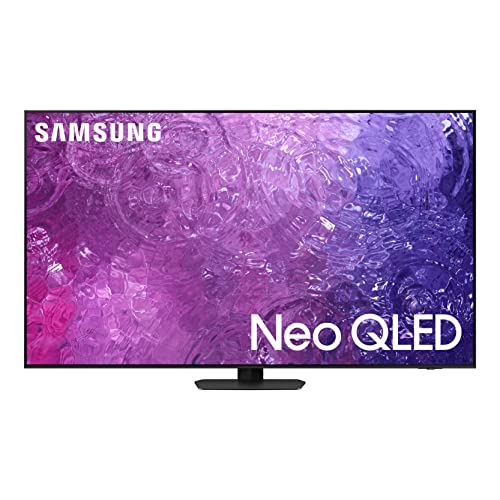
True Score
86869Experts
925kCustomers
Absolutely Fresh
 SAVE $1$1,699.99$339.99
SAVE $1$1,699.99$339.99Snapshot
Reasons to Buy
- Superb picture quality
- High brightness and contrast
- Low-tested response time and input lag
- High refresh rate and VRR support
Reasons to Avoid
- Moderate viewing angle
- Mild blooming
Specifications
Max Resolution 3840 x 2160 (4k) 
Backlight Type Full-Array Refresh Rate 120 Hz Display Type LED HDMI Inputs 4 
HDMI Type HDMI 2.1 HDR Format HDR10+, HLG 
HomeKit Compatible No 
Number of Audio Channels 4.2.2 
Panel Type Neo QLED Screen size 43", 50", 55", 65", 75", 85" 
Smart Platform Tizen 
Speaker Output 60 watts 
VRR Yes 
Works With Amazon Alexa, Bixby, Bluetooth, Google Assistant, Remote Control, SmartThings, Wi-Fi All Specs
Test Results
SDR Brightness (nits) 1,289 HDR Brightness (nits) 1,923 Color Gamut % (DCI P3 xy) 93.335 Response Time (ms) 10.2 Contrast Ratio (x:1) 83,200 EOTF (600 nit delta) 0.0046 Color Gamut % (DCI P3 uv) 93.64 Color Gamut % (Rec 2020 xy) 72.73 Color Gamut % (Rec 2020 uv) 75.69 Color Gamut % (sRGB) 98 Color Gamut % (Rec 709) 99.77 Color Gamut % (BT.2020) 73 Color Gamut % (Adobe RGB) 79.1 Color Gamut % (BT.709) 0 Input Lag (ms) 10 Color Washout (Degrees) 26 Color Shift (Degrees) 51 Brightness Loss (Degrees) 32 Reflections (%) 1.5 Low-Freq Extension (Hz) 100.79 Freq Response StdDev @ 70db 1.61 Freq Response StdDev @ 80db 2.38 Weighted Total Harmonic Distortion @80db 0.334 Intermodulation Distortion @80db 0.31 EOTF (1000 nit delta) 0.0046 EOTF (4000 nit delta) 0.0044 All Tests
All Retailers
- $339.99$1,700Save $1
Availability
In StockFree Shipping
No - $1,459.00$1,500Save $41
Availability
In StockFree Shipping
No - $1,747.95
Availability
In StockFree Shipping
No
Our Verdict
If you’re a cinephile, the Samsung QN90C offers up best-in-class EOTF performance of 0.0046, giving it the most accurate gamma out of any TV on the list. Coupled with its very strong HDR brightness of 1923 nits and SDR Brightness of 1289 nits, this TV offers up excellent bright room performance that can transition into home theater content effortlessly.
While viewing angles are a common weakness with LEDs and the QN90C is no different, it does offer the best overall viewing angles, at 26 degrees before color washout begins. Fortunately, the TV’s reflections handling is impressive, coming in at a best-in-class 1.5% reflected light, helping minimize glare when setting the TV up in brightly lit rooms. When combined with the TV’s best-in-class input lag of 10 ms, the QN90C makes a niche for itself as an excellent TV for gamers looking to set up in a room with lots of ambient light.
All told, the Samsung QN90C features strong brightness and exceptional EOTF accuracy, complemented by its performance in maintaining color integrity and minimizing reflections. This makes it an ideal choice for anyone looking to play games or watch movies in rooms that are pitch-black or drenched in sunlight.

Best Overall

Runner Up

Best Value

Best Budget

Best Mid-Range

Premium Pick
TCL QM8/QM850G QLED TV
Best For Gaming
With unmatched brightness and solid HDR performance, the TCL QM8 shines in brightly lit spaces, offering vibrant colors and fluid motion for sports, despite its casual gaming limitations.
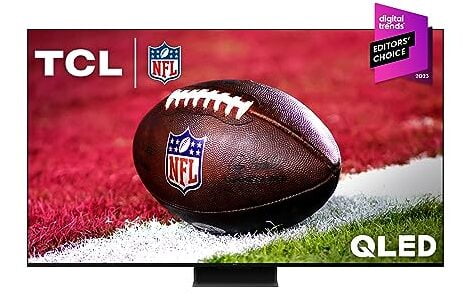
True Score
83847Experts
90488Customers
Absolutely Fresh
 SAVE $50$999.99$949.99
SAVE $50$999.99$949.99Snapshot
Reasons to Buy
- Outstanding picture quality
- Spectacular brightness and contrast ratio
- Rapid response time
- Super low input lag
Reasons to Avoid
- Disappointing viewing angles
Specifications
Max Resolution 3840 x 2160 (4k) 
Backlight Type Full-Array Refresh Rate 120 Hz 
Depth 11.7" Display Type QLED HDMI Inputs (Total) 2 
HDMI Type HDMI 2.1 HDR Format Dolby Vision, HDR10, HDR10+, HLG 
Height 34.1" High Dynamic Range (HDR) Yes 
Number of Audio Channels 3 
Panel Type LED Screen size 65", 75", 85", 98" 
Smart Platform Google TV 
Speaker Output 40 Watts 
Sync Technology AMD FreeSync Premium Pro 
VRR Yes 
Voice Assistant Google Assistant 
Weight 54.7 lbs 
Width 56.9" 
Works With Amazon Alexa, Apple HomeKit, Google Assistant All Specs
Test Results
SDR Brightness (nits) 2,076 HDR Brightness (nits) 2,005 Color Gamut % (DCI P3 xy) 94.59 Response Time (ms) 8.9 Contrast Ratio (x:1) 114,057 EOTF (600 nit delta) 0.037 Color Gamut % (DCI P3 uv) 97.31 Color Gamut % (Rec 2020 xy) 75.81 Color Gamut % (Rec 2020 uv) 80.57 Color Gamut % (sRGB) 0 Color Gamut % (Rec 709) 0 Color Gamut % (BT.2020) 0 Color Gamut % (Adobe RGB) 0 Color Gamut % (BT.709) 0 Input Lag (ms) 14.3 Color Washout (Degrees) 24 Color Shift (Degrees) 31 Brightness Loss (Degrees) 32 Reflections (%) 1.8 Low-Freq Extension (Hz) 89.8 Freq Response StdDev @ 70db 4.74 Freq Response StdDev @ 80db 4.67 Weighted Total Harmonic Distortion @80db 0.128 Intermodulation Distortion @80db 8.67 EOTF (1000 nit delta) 0.0238 EOTF (4000 nit delta) 0.0271 All Tests
All Retailers
- $949.99$1,000Save $50
Availability
In StockFree Shipping
No - $998.00$1,136Save $138
Availability
In StockFree Shipping
Yes - $1,299.00
Availability
In StockFree Shipping
Yes
Our Verdict
If you need a TV for an extremely bright room with a ton of natural sunlight, the TCL QM8 distinguishes itself with top-tier brightness. With an SDR Brightness of 2076 nits and HDR Brightness of 2005 nits, this best-in-class brightness ensures an exceptionally bright and vivid display, enhancing visibility and detail in both standard and high dynamic range content.
While it struggles with input lag, clocking in at the lowest position overall with 14.3 ms, it’s still good enough to use for casual gaming in brightly lit environments. Despite the compromise on input lag, the QM8 doesn’t compromise with response time, offering a best-in-class response time of 8.9 ms, making it the best possible option for anyone looking to enjoy high-intensity sports, especially in very sunny rooms.
Overall, the TCL QM8’s leading brightness levels and solid HDR performance position it as a formidable choice for users who prioritize picture quality or fluid motion for sports. Its QLED technology further ensures vibrant colors and deep contrasts, enhancing the overall viewing experience and offering incredible bright room performance at an accessible price point.
DID YOU KNOW 87% OF TV REVIEWERS ARE UNTRUSTWORTHY?
Our research found 28 of 210 TV reviewers can be trusted, and shockingly 1 out of 3 on Google Page 1 were fake reviews showing no proof of test claims. See our Expose and Trust List. This is why Gadget Review is committed to calculating the most accurate product scores on the web.
To do this, we give every TV review site a Trust Rating, which measures how trustworthy the site and their testing claims are. We then leverage AI & a machine learning model to combine and calculate the Trust Rating with data from experts and consumers to deliver the True Score, the web’s most accurate product quality rating.

Best Overall

Runner Up

Best Value

Best Budget

Best Mid-Range

Premium Pick
Hisense U7K
The Hisense U7K combines strong value with impressive color coverage and response time, making it a great budget pick for home theater enthusiasts and sports fans in moderately lit rooms.
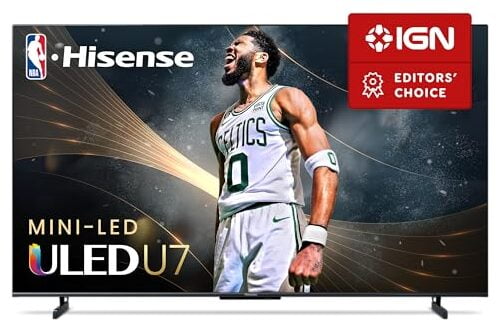
True Score
83859Experts
87831Customers
Absolutely Fresh
 SAVE $40$799.99$759.99
SAVE $40$799.99$759.99Snapshot
Reasons to Buy
- Outstanding picture quality in the dark
- High peak brightness
- Fast response time and low input lag
- 120 Hz refresh rate
Reasons to Avoid
- Subpar off-center viewing
- Average blooming
Specifications
Max Resolution 3840 x 2160 (4k) 
Backlight Type Full-Array Refresh Rate 120 Hz Display Type LED HDMI Inputs 4 
HDMI Type 2.0, HDMI 2.1 HDR Format Dolby Vision, HDR10, HDR10+, HLG 
HomeKit Compatible – 
Number of Audio Channels 2.1 
Panel Type IPS Screen size 55", 65", 75" 
Smart Platform Google TV 
Speaker Output 40 Watts 
Sync Technology HDR Format 
VRR Yes All Specs
Test Results
SDR Brightness (nits) 603 HDR Brightness (nits) 786.5 Color Gamut % (DCI P3 xy) 96.31 Response Time (ms) 11.3 Contrast Ratio (x:1) 45,000 EOTF (600 nit delta) 0.0211 Color Gamut % (DCI P3 uv) 97.4 Color Gamut % (Rec 2020 xy) 76.18 Color Gamut % (Rec 2020 uv) 81.91 Color Gamut % (sRGB) 98.5 Color Gamut % (Rec 709) 0 Color Gamut % (BT.2020) 76 Color Gamut % (Adobe RGB) 80.5 Color Gamut % (BT.709) 0 Input Lag (ms) 14.3 Color Washout (Degrees) 23 Color Shift (Degrees) 23 Brightness Loss (Degrees) 35 Reflections (%) 1.9 Low-Freq Extension (Hz) 89.8 Freq Response StdDev @ 70db 4.36 Freq Response StdDev @ 80db 4.48 Weighted Total Harmonic Distortion @80db 0.096 Intermodulation Distortion @80db 4.47 EOTF (1000 nit delta) 0.021 EOTF (4000 nit delta) 0.013 All Tests
All Retailers
- $759.99$800Save $40
Availability
In StockFree Shipping
No - $800.00
Availability
In StockFree Shipping
No - $1,074.06
Availability
In StockFree Shipping
No
Our Verdict
If you’re looking for a TV that works with just about anything, the Hisense U7K is basically the “little brother” of the U8K but features a lower price and better response time, making it a better option for anyone looking to get the most out of fast-paced sports, especially on a budget.
With an HDR brightness of 786.5 nits and SDR brightness of 603 nits, the Hisense U7K demonstrates a capable display that can handle a variety of content with ease, but isn’t as suited to bright rooms as the U8K.
Still, it’s a 4K LED TV with 120 Hz refresh rate and HDMI 2.1 ports, meaning it can reasonably tackle any modern content, be it movies, games or HDR content. Plus, the TV covers 96.31% of the DCI P3 xy color gamut, making it the second best for color accuracy and coverage out of all the TVs on the list and cementing it as a great option for enjoying home theater content – as long as the room isn’t too bright.
Ultimately, the Hisense U7K TV is a compelling option for a broad audience looking to really stretch their dollar as far as they can. Its performance, marked by respectable brightness and a solid overall feature set positions it as a wise choice for anyone looking to maximize their investment in a quality TV.

DON’T SEE WHAT YOU’RE LOOKING FOR?
Make sure to explore our guide on the top TV brands, or if you prefer the best picture possible, check out our selections of the finest OLED TVs. Don’t overlook the importance of resolution in your decision-making process. To equip yourself with a cutting-edge setup, consider our guide on premium 8k TVs and understand the diffferences between 4K vs 8K resolutions.
For a versatile display, our roundup of the best TV monitors provides options perfect for both productivity and relaxation. Additionally, if you’ve invested in a soundbar, our tutorial on connecting a soundbar to your TV will ensure you get the best sound quality possible.

Best Overall

Runner Up

Best Value

Best Budget

Best Mid-Range

Premium Pick
Hisense U8K TV
Best For Home Theater
A versatile LED TV excelling in color accuracy and bright room performance, the Hisense U8K offers a solid all-around viewing experience without the worry of burn-in, ideal for diverse content and environments.
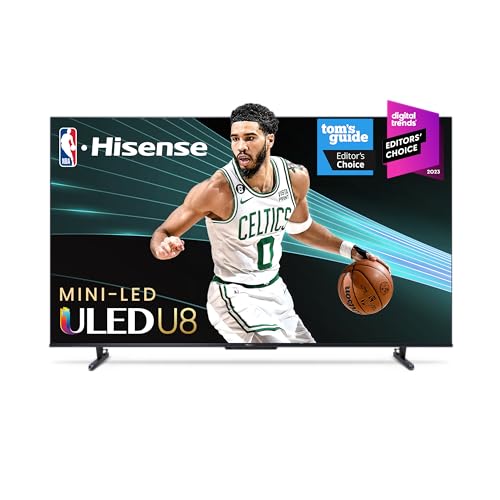
True Score
78796Experts
831kCustomers
Mixed Reviews
 SAVE $150$999.99$849.99
SAVE $150$999.99$849.99Snapshot
Reasons to Buy
- Good picture quality
- Outstanding brightness and good contrast ratio
- Quick response time
- Great reflection handling
Reasons to Avoid
- Poor viewing angles
Specifications
Max Resolution 3840 x 2160 (4k) 
Backlight Type Full-Array Refresh Rate 144 Hz 
Depth 3" Display Type LED HDMI Inputs (Total) 4 
HDMI Type HDMI 2.1 HDR Format Dolby Vision, HDR10, HDR10+, HLG 
Height 33.1" High Dynamic Range (HDR) Yes 
Number of Audio Channels 2.1.2 
Panel Type VA Screen size 100", 55", 65", 75", 85" 
Smart Platform Google TV 
Speaker Output 50 Watts 
Voice Assistant Google Assistant 
Weight 56.4" lbs 
Width 57.2" 
Works With Google Assistant All Specs
Test Results
SDR Brightness (nits) 1,549 HDR Brightness (nits) 1,792 Color Gamut % (DCI P3 xy) 97.44 Response Time (ms) 13.3 Contrast Ratio (x:1) 165,360 EOTF (600 nit delta) 0.0105 Color Gamut % (DCI P3 uv) 97.01 Color Gamut % (Rec 2020 xy) 76.18 Color Gamut % (Rec 2020 uv) 81.82 Color Gamut % (sRGB) 0 Color Gamut % (Rec 709) 0 Color Gamut % (BT.2020) 80 Color Gamut % (Adobe RGB) 0 Color Gamut % (BT.709) 0 Input Lag (ms) 14.2 Color Washout (Degrees) 23 Color Shift (Degrees) 23 Brightness Loss (Degrees) 35 Reflections (%) 1.8 Low-Freq Extension (Hz) 80 Freq Response StdDev @ 70db 2.06 Freq Response StdDev @ 80db 2.11 Weighted Total Harmonic Distortion @80db 0.1 Intermodulation Distortion @80db 0.71 EOTF (1000 nit delta) 0.0106 EOTF (4000 nit delta) 0.011 All Tests
All Retailers
- $849.99$1,000Save $150
Availability
In StockFree Shipping
No - $997.99
Availability
In StockFree Shipping
No - $1,450.40
Availability
In StockFree Shipping
No
Our Verdict
The Hisense U8K TV sets the bar for LED TVs with a best-in-class DCI P3 xy color gamut coverage of 97.44%. Its ability to accurately reproduce a wide range of colors pairs well with its ability to tackle a variety of viewing conditions with its bright display.
Clocking in at 1549 nits for SDR and 1792 nits for HDR, it isn’t the brightest on the list, but still pumps out enough light to overcome most ambient light sources, making the TV an excellent choice for brightly lit rooms while still enhancing HDR content.
Like every other LED TV on this list, the U8K benefits from not having to worry about burn-in. And while it’s not the best pick for competitive gamers, its 14.2 ms input lag and LED panel make it still plenty fast for more casual gamers that love marathon sessions.
If you need a versatile TV, particularly for bright rooms, the U8K is an excellent choice. It offers up solid, jack-of-all-trades performance, and delivers fantastic, accurate colors for SDR and HDR content alike.

Our Approach to Testing LED TVs
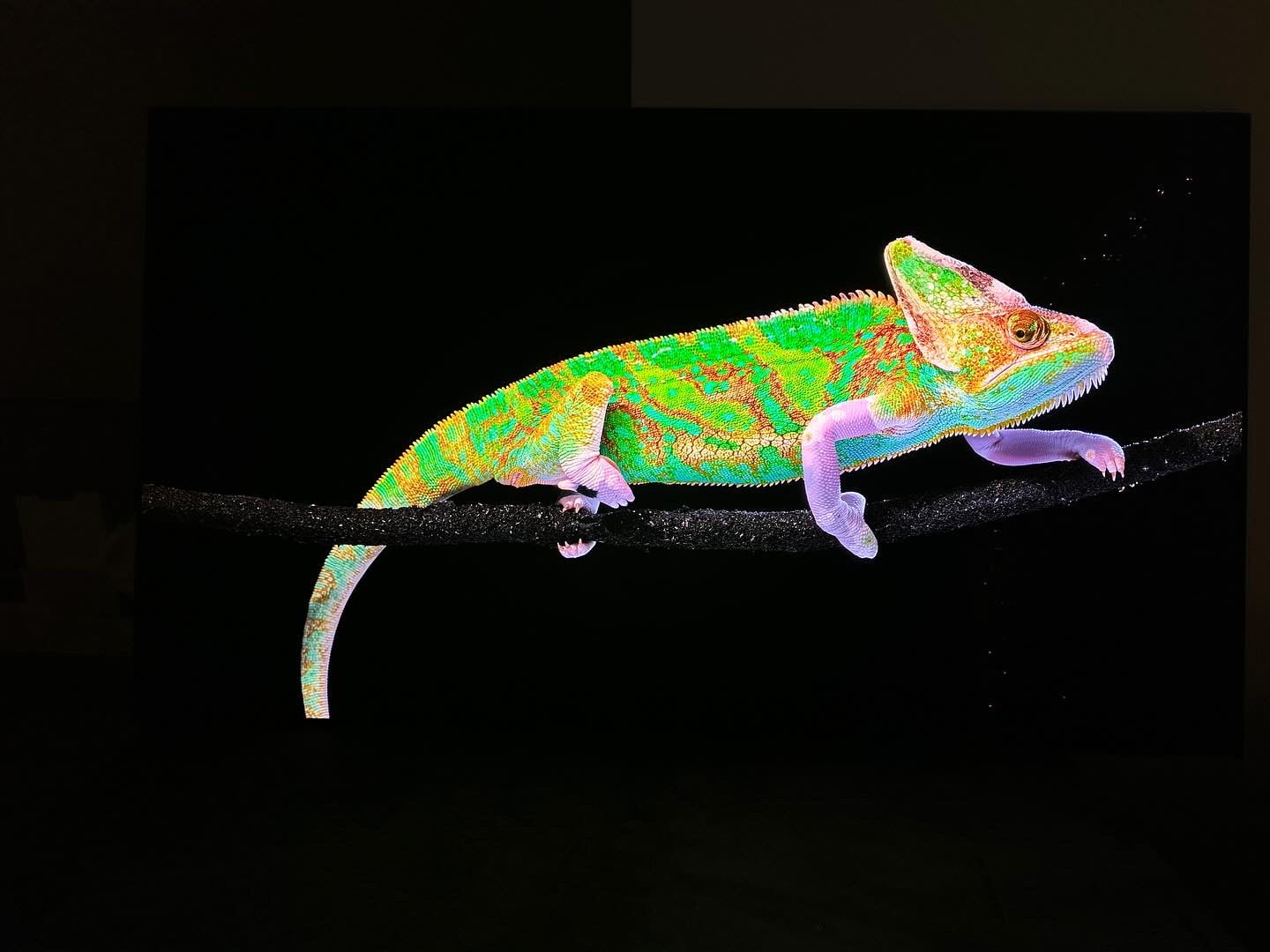
Evan Shepard/Gadget Review
We’ve redefined TV buying guides, setting us apart from any other site on the planet. Our unique approach combines in-house verification with a comprehensive dataset from trusted sites, focusing on key testing metrics like brightness (SDR and HDR), EOTF, response time, contrast ratio and color gamut.
You can enjoy premium picture quality without breaking the bank by opting for the best LED TV. LED TVs offer savings and peace of mind compared to OLED, with affordable options from brands like HiSense and TCL utilizing MiniLED and QLED technology. Even with a budget under $1000, you can access TVs that provide vibrant colors, deep blacks, and sharp details, ensuring quality viewing experiences while keeping your wallet intact. What’s the next step?
You may notice some of our graphs contain “Source: RTings”. This is to indicate that the data we’re showing off in a graph has come from a single source – because it’s the only source that actually tested the criteria and had data for it! Normally, our data is an average out of all of the various publications that test and provide data to give you a good idea of how a product is going to perform on average.
Which Criteria Matters for Testing LED TVs?
By focusing on these criteria (3 required, 3 nice to have), anyone can quickly and easily compare these TVs and how they’ll perform. This helps you make an informed decision and purchase a LED TV.
| CRITERIA | RANGE | REQUIRED | DEFINITION |
|---|---|---|---|
| SDR Brightness | 600+ nits | Yes | Assess the luminance of your display when operating in Standard Dynamic Range (SDR) mode. |
| HDR Brightness | 1100+ nits | Yes | Determine the luminance of your display in High Dynamic Range (HDR) mode. |
| Color Gamut (DCI P3 xy) | >= 90% | Yes | Evaluate the extent to which a TV can reproduce a specified spectrum of colors. |
| EOTF | 0.018 | No (nice to have) | Standard that governs how a display interprets and renders brightness and color. |
| Response Time | <=10ms | No (nice to have) | Time required for a pixel to transition from one color to another and then return to its original color. |
| Contrast Ratio | >= 10,000 | No (nice to have) | The ratio between the brightest white and darkest black that the screen can display. |
Our Trusted Data Sources
(Publication category Score is 80%+)
We looked at 210+ TV reviewers and while 24 are trustworthy (60%+ Trust Rating), we only use data from the testers that are “very trusted” which means a Trust Rating above 70%. The three we have listed below are our most trusted for TVs, along with our own in-house TV expert.
- Evan Shepard – Gadget Review
- Matthew Lopes – RTings, MuckRack
- Will Greenwald – PCMag, MuckRack, Twitter
- David Katzmaier – CNET, MuckRack, Twitter
Interested in a comprehensive analysis of our data sources? We’ve got you covered. Below, you’ll find a detailed list of every TV review website we’ve identified, organized by their respective Trust Ratings from highest to lowest. But we didn’t stop there. We’ve meticulously reviewed each publication and verified the data by checking whether the authors have bio links to MuckRack or LinkedIn. We’re committed to not only checking the facts but ensuring their veracity.
Best LED TVs Test Data & Results
1. SDR & HDR Brightness TV Test Results
In well-lit rooms, the brightness level of your LED TV, quantified in nits, is key to a great viewing experience. A TV that doesn’t meet the brightness requirement will struggle against natural and artificial light, resulting in a dim, lackluster image. Essentially, nits measure how well your TV can stand up to light interference, with higher values ensuring a sharper, more vivid display.
For standard viewing on the best LED TV, you should look for at least 600 nits to strike the right balance between clarity and color quality in standard dynamic range (SDR) content. For high dynamic range (HDR) content, which offers richer colors and greater contrast, a minimum of 1100 nits is ideal to truly appreciate the enhanced visuals. These brightness levels are recommended to ensure your TV performs well in bright settings, allowing you to enjoy your shows and movies without any loss in detail or quality. Aim for these minimums: SDR Brightness >= 600 nits; HDR Brightness >= 1100 nits for the optimal experience.
Discover the top LED TVs, ranked from brightest to least, all exceeding our brightness criteria.
Brightness
SDR: 600+ nits
HDR: 1100+ nits
Acceptable range of performance
Definition: Maximum brightness in a specified pattern size window. Most commonly measured in a 10% or 100% white window.
Units of Measurement: nits (alternatively cd/m²)
Tools to Measure: TV, luminance meter
Why It’s Important:
Brightness helps counter ambient light so that details and colors don’t wash out and get lost.
SDR Brightness (in nits, higher is better)
HDR Brightness (in nits, higher is better)
2. Color Gamut (DCI P3 xy) TV Test Results
Color Gamut
>= 90%
Acceptable range of performance
Definition: The TV’s capability to display a spectrum of colors.
Units of Measurement: % (color space coverage in percent)
Tools to Measure: Colorimeter
Why It’s Important:
Inaccurate colors compromise the authenticity of the content.
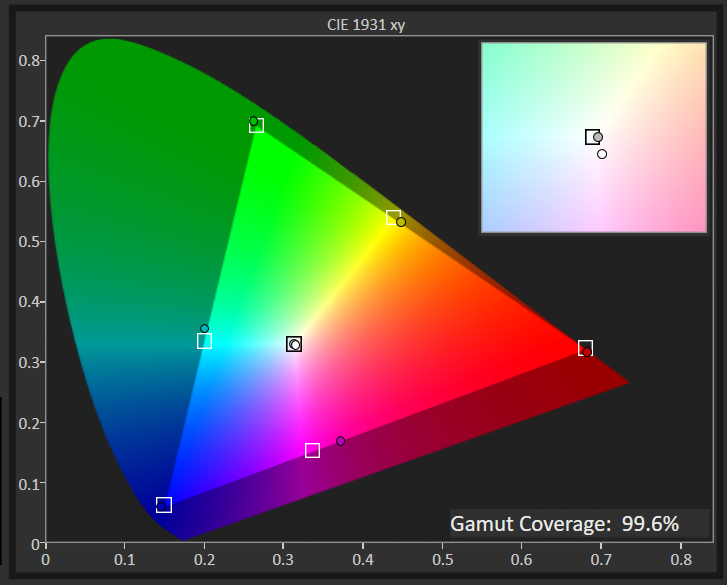
Color gamut defines the range of colors a LED TV can reproduce, directly affecting how vibrant and true-to-life the images look. A wide color gamut in a LED TV brings out richer, more vivid colors – from the lush greens of a garden to the bright colors of animated characters, enhancing your viewing experience to closely mimic real life.
This concept is technically measured against standards like the DCI P3 xy, a benchmark for high-quality visuals. A LED TV covering a higher percentage of this color space can display colors more accurately and vividly.
For those who prioritize vibrant and immersive visuals, aiming for a LED TV with a color gamut of 90% or higher on the DCI P3 xy scale is ideal. This ensures that the content you watch is as vibrant and lifelike as possible.
Below are the top LED TVs, ordered by color gamut, all exceeding our testing criteria.
DCI P3 XY Color Gamut (as a %; high is better)
3. EOTF Test Results
The Electro-Optical Transfer Function (EOTF) plays a critical role in ensuring the content on your TV looks exactly as the creator intended. This technical feature adjusts your screen’s brightness levels, ensuring every scene, from the darkest shadows to the brightest highlights, is displayed with true-to-life accuracy.
In rooms flooded with light, a TV that nails EOTF calibration shines by preserving the intended contrast and detail in the picture despite the challenging conditions. It balances the brightness so that images remain vibrant and full of detail, unaffected by the glare of ambient light.
A TV that excels in managing EOTF offers an immersive and authentic viewing experience. It brings creators’ visions to life, accurately rendering every scene with the proper light and dark levels, no matter the lighting in your room. This means you get a consistent, realistic picture that captures the full spectrum of colors and contrasts, from the subtlest hues to the most intense explosions.
Below are all the Best LED TVs on our list, ordered by EOTF, from best to worst.
EOTF
< 0.018 (600 nit Δ)
Acceptable range of performance
Definition: How your TV interprets and renders the luminance data from content and translates it to be represented on screen. If EOTF/Gamma tracking is too low or too high, it will result in an over-brightened or over-darkened image from reference.
Units of Measurement: this test measures for the delta from the standard
Tools to Measure: Luminance colorimeter
Why It’s Important:
EOTF ensures that the game is displayed (color and HDR brightness) as the creator intended it
EOTF (source: rtings.com – 0 = no data exists; lower is better)
4. Response Time TV Test Results
Response Time
1ms-10ms
Acceptable range of performance
Definition: Speed at which a pixel transitions from one color to another
Units of Measurement: milliseconds (ms)
Tools to Measure: Screen, camera, test software
Why It’s Important:
A faster response time means less blur and thus more accuracy
A slow response time on a LED TV during fast-paced scenes is like trying to watch a thrilling movie with a foggy lens. Imagine settling in for an action-packed sequence, only to have the swift movements turn into a blur, robbing you of the crisp, clear detail you crave. This isn’t just a minor annoyance; it’s a major detriment to your viewing experience, leaving you with a picture marred by motion blur and visual artifacts.
So, what exactly is response time? It measures how quickly a pixel on your TV can change from one color to another. In the context of watching fast-moving content or enjoying dynamic scenes on a LED TV, a low response time is crucial. A response time of 15 ms or lower is good, but if you plan on gaming on this set, aim for a response time of 10 ms or lower. The best gaming TVs prioritize the lowest possible response times to enhance gameplay. At these levels, your LED TV ensures smooth transitions and sharp visuals, making every scene come to life without any distracting blurs or delays.
Below are the top LED TVs, ordered by response time.
Response Time (in milliseconds; lower is better)
5. Contrast Ratio Test Results
For LED TV enthusiasts, a solid contrast ratio is crucial for enjoying your favorite TV shows or movies, especially in darker settings. This feature directly impacts how lifelike and dynamic the picture appears on your screen, ensuring that dark scenes are displayed with clear, crisp blacks instead of murky grays and bright scenes retain their detail without appearing washed out.
Put simply, the contrast ratio is all about the range of luminance a TV can produce, from the deepest blacks to the brightest whites. It’s what brings depth to the image, enhancing the realism of every scene. Watching a movie in the dark, for example, the difference between a TV with a poor contrast ratio and one with a high ratio is stark: the former struggles, blending shadows into a flat gray, while the latter delivers true black, making night scenes more immersive and detailed.
Below are the top LED TVs, ordered by contrast ratio, all exceeding our testing criteria.
Contrast Ratio
>=10,000:1
Acceptable range of performance
Definition: Difference between the darkest black and the brightest white a screen can display.
Units of Measurement: cd/m2
Tools to Measure: Luminance meter
Why It’s Important:
A higher contrast ratio delivers deeper blacks, enhancing content definition, especially in darker rooms.
Contrast Ratio (higher is better)
Best LED TVs: Mistakes To Avoid
- Ignoring Picture Quality: Focusing solely on specifications like resolution or size without considering factors such as contrast ratio, color accuracy, and viewing angles can lead to a disappointing viewing experience. Understanding the difference between backlight and brightness on a TV is crucial, as it impacts the overall picture quality. Backlight determines the illumination of the screen, while brightness affects how vibrant images appear. Additionally, when considering QLED vs LED, it’s important to note that QLED TVs, with their quantum dot technology, can offer better backlight control and brightness levels compared to standard LED TVs, enhancing the viewing experience with more vivid colors and deeper contrasts.
- Not Researching Brands and Models: Buying solely based on price or brand popularity without researching specific models can result in missing out on better-performing options within your budget. For instance, the best 55-inch TVs can offer a sweet spot in terms of size and performance for many living spaces, providing an immersive viewing experience without overwhelming the room.
- Overlooking Refresh Rate: For smoother motion during fast-paced scenes, it’s essential to consider the TV’s refresh rate. Overlooking this can lead to motion blur or stuttering in action-packed content. If you are a sports enthusiast, the top TVs for sports should have high refresh rates to ensure a smooth picture during fast-paced action.
- Not Checking Connectivity Options: Ensure the TV has sufficient HDMI ports, USB ports, and other inputs to accommodate your devices. Overlooking this can cause inconvenience when connecting gaming consoles, streaming devices, or other peripherals.
The Best LED TV’s Tests Compared
Product |
True Score
|
SDR Brightness
|
HDR Barightness
|
Color Gamut
|
EOTF
|
Response Time
|
Contrast Ratio
| |
|---|---|---|---|---|---|---|---|---|
| 86 |
|
|
|
|
|
| $259.99 $1,300 $1 |
| 83 |
|
|
|
|
|
| $299.99 $1,500 $1 |
| 83 |
|
|
|
|
|
| $759.99 $800 $40 |
| 78 |
|
|
|
|
|
| $698.00 $800 $102 |


